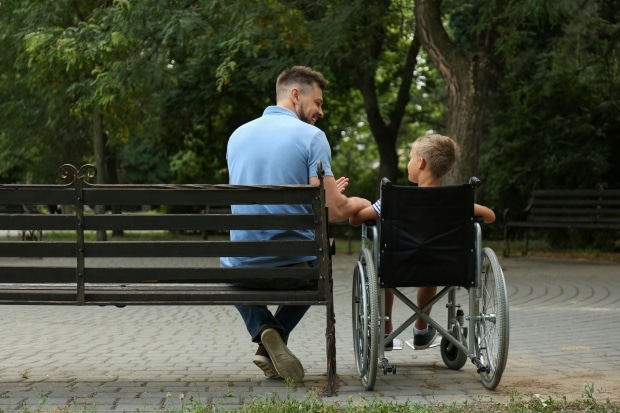Disability Pride Month
There’s a good chance you may not be familiar with Disability Pride month, as it’s a relatively new concept. However, more people should take the time to learn about disability pride and its importance in our society.
If you’re a stepparent to a child with disabilities, then you should definitely take the time to learn about Disability Pride Month. Not only will it help you to understand your stepchild better, but it can also be a great way to show your support for them.
Learning about disability pride could help you to build your stepchild’s confidence and self-esteem as well.
What is Disability Pride?
According to the Disability Community Resource Center, individuals with disabilities need to be proudly visible in the community.
Although no one is defined by whatever disability they may have – be it a spinal cord injury, cerebral palsy, depression, or something else entirely – disabilities are a part of many of our identities. Just as we may identify with our gender, height, race, and so on, many of us also identify with our disabilities.
Of course, we are so much more than a medical diagnosis. We are all multi-faceted, and there are many things we may identify with that makes us who we are; but, it’s so important to recognize that all identities have value and should be celebrated.
Disability Pride is about reshaping the attitude many people have towards those with disabilities. No matter what you may personally identify with, it’s so important to take pride in yourself and what makes you, well, you. The same is true of others.
Dr. Martin Luther King, Jr. famously said, “As long as the mind is enslaved, the body can never be free.”
History of Disability Pride Month
On July 26th, 1990, Congress passed the Americans with Disabilities Act (ADA). This landmark legislation made discrimination against people with disabilities illegal. The same day this law was passed, Boston held the very first Disability Pride Day.
Although Disability Pride Day is not a nationally recognized holiday, numerous cities across the nation celebrate with parades. Los Angeles, New York, and San Francisco are just a few cities to host Disability Pride parades.
July 26th may be the unofficial Pride Day, but celebrations recognizing individuals with disabilities occur during the entire month of July. Although disability pride month is not as well-known as other pride months, it does have its pride flag.
There’s no doubt as time goes on, this pride month will become just as widely commemorated as others.
As an Able-Bodied Person, Show Support by Being Respectful
It should be common sense and common courtesy to treat disabled people with the same respect you would a non-disabled person.
To be as respectful as possible, as a non-disabled person, keep the following tips in mind:
Ask Before Helping
Numerous people may be tempted to help a disabled person before they even have a chance to ask for help. This is a mistake.
Nobody wants to feel like a charity case or that someone is doing something nice out of pity for them. Just like anybody else, a disabled person will ask for help if they need it.
Automatically helping without asking first can be particularly detrimental to the confidence of disabled children. Childhood is a sensitive time for most people with disabilities, and they must gain confidence in their independence.
Of course, there can be exceptions to this rule. In an emergency, you don’t need to ask for help.
Don’t Lean on Wheelchairs
It’s probably safe to assume you wouldn’t lean on a person who is standing. For the same reason, you wouldn’t lean on a non-disabled person, and you shouldn’t lean on a disabled person’s wheelchair.
It’s incredibly rude and even dehumanizing.
Keep Eye Contact with a Deaf/Hearing-Impaired Person
Be careful not to exclude the person you want to talk to from the conversation. Keep eye contact and speak to them like you would with any other person. The interpreter will know how to take it from there.
Identify Yourself to a Visually Impaired Person
Individuals with visual impairments are not able to see physical cues like non-disabled people. This means that it’s incredibly important to be communicative verbally with them.
They will appreciate this gesture, and it will make them feel more comfortable with you.
Avoid Excessive Flattery
The problem with words like these is they tend to be given to a disabled person when they’re doing something mundane, like simply pouring a glass of water. Even if you want to give a genuine compliment, poor timing can make the statement seem insincere.
Or, even worse, the statement could make them feel like they’re different and somehow less capable. Children are especially sensitive to these kinds of statements because they put so much effort into being like everyone else.
Pointing out any potentially negative differences they may have from other kids can devastate a kid with disabilities. Nobody likes to be singled out.
Everyone wants to be praised when they do something great, just as most people find excessive flattery for trivial things to be insulting. Every disabled person lives normally.
Non-disabled people don’t want or need “compliments” for doing ordinary things, and neither do disabled people.
Respect and Understand Confidentiality
Don’t expect a disabled person to talk about their disability with you. Like anybody else, a disabled person has the right to privacy, and it is their choice on who they want to share the details of their life with.
Being a Stepparent to a Disabled Child
For both biological parents and stepparents, parenting isn’t easy. Each child presents unique challenges for parents to face. This is true of both disabled and non-disabled children.
With that being said, there are some key things for parents, especially stepparents, to be aware of when caring for their disabled child.
If you are a new stepparent to a child with a disability, here are some helpful tips:
Knowledge is Power
In all honesty, whether you have children of your own or not, stepping into the role of a stepparent to a disabled child can be a bit intimidating if you have no prior experience with children with special needs. Your spouse is likely a walking encyclopedia of information concerning the child’s specific disability, and it wouldn’t be abnormal for you to be overwhelmed by all of this new information.
Also, probably, your spouse has carefully crafted a specific routine that revolves around the child’s needs. If they have been taking care of the child on their own for some time, having someone join the team to help support the child may be an adjustment for all of you.
Communication is vital. Discuss ways you can get involved in the set routine with your spouse. Be open about any emotions you may have.
If you’re invited to accompany your spouse and stepchild to appointments, don’t be afraid to ask your stepchild’s doctor questions or address concerns with them.
However, always be sure to be respectful of both your stepchild and spouse. Your unique perspective as a stepparent matter, but be careful not to overstep boundaries.
Be Honest
Setting well-defined boundaries will help keep either of you from creating unrealistic expectations that later turn into resentment. This advice is important for any new stepparent.
Be clear with your spouse about what you are and are not comfortable doing. Taking on more than you can handle will not be helpful to your spouse or your stepchild.
This topic may be discussed many times throughout your marriage, as it’s natural for your comfort level to change as you gain more experience with your stepchild’s specific needs and become more confident in your role as a stepparent.
Make Adjustments
Becoming a stepparent means you’ll need to open your heart and your home to your new family. With a disabled child, this may require some modifications and adjustments to your house to ensure their safety.
If you’re unsure of the necessary modifications that may need to be made for your stepchild, be sure to consult your spouse. As a walking encyclopedia on their child’s needs, they will certainly provide any needed guidance. As mentioned above, knowledge is power.
The age of your stepchild and the severity and type of disability they have will greatly affect the modifications you may need to make.
Be There for Your Stepchild
Sadly, too many disabled individuals feel alienated and cut off from the rest of society. This creates a sense of loneliness that can be tough to endure.
Schedule fun activities for both of you to enjoy together regularly. Spending time with your stepchild will help the two of you to develop a strong bond. They’ll forever cherish the memories that the two of you will make.
In addition to spending time together, you can celebrate Disability Pride with them. Teach your stepchild to love and accept themself as they are. Would you mind encouraging them to embrace all of the things that make them unique individuals, even their disabilities?
Final Words
Becoming a stepparent to a child with special needs is an experience that will change your life. But the same is true with becoming a stepparent to a non-disabled person.
It’s okay to feel intimidated by taking on a new role as a stepparent. That is perfectly normal. But know that you are perfectly capable of being a wonderful stepparent to your stepchild.
Your spouse will be by your side, offering guidance and support along the way. And numerous resources are easily available to help educate you with any questions or concerns you may have.
We all want to feel loved, appreciated, and proud of who we are. People with disabilities are no different.








